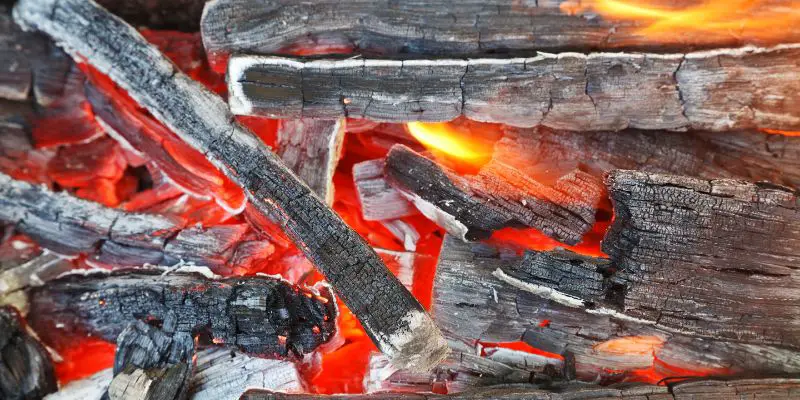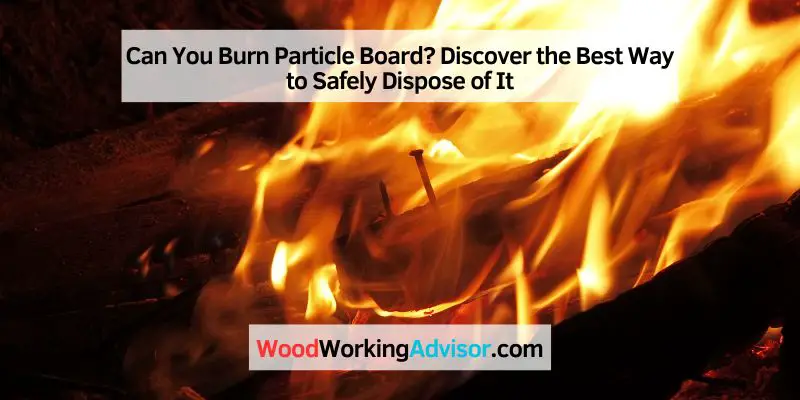Yes, particle board can be burned as it is made from wood and other materials bonded together using heat and pressure. Particle board, a composite wood product, consists of wood chips or sawdust mixed with a synthetic resin adhesive and compressed under high temperatures.
By burning particle boards, the wood and resin components release smoke and fumes, posing potential health and environmental hazards. However, burning particle boards should only be done in well-ventilated areas and adhering to local regulations to prevent harmful emissions. It is important to note that proper disposal methods, such as recycling or contacting waste management facilities, should be considered rather than burning particle boards.
Understanding the risks associated with burning particle boards is crucial for maintaining a safe and sustainable environment.
Understanding Particle Board
Particle board is not suitable for burning due to its composition of wood particles and adhesive. When burned, it releases toxic fumes and chemicals, posing health risks. Understanding this is crucial for safe and responsible disposal of particle board products.
Introduction:
Particle board is a widely used material in the construction and furniture industries due to its affordability and versatility. Made from wood particles and adhesive, it is an engineered wood product that offers several advantages. In this section, we will delve into the composition of particle board and explore its properties.
Composition Of Particle Board
Particle board is primarily composed of wood particles, also known as wood chips or flakes, along with an adhesive binder. The wood particles used in the manufacturing process can vary in size and shape and are often sourced from various types of wood, including pine, fir, and recycled wood. The precise combination of wood particles and adhesive can influence the strength and durability of the resulting particle board.
Properties Of Particle Board
Particle board possesses several properties that make it an attractive choice for both residential and commercial applications. Let’s take a closer look at some of these properties:
1. Affordability: Particle board is known for being more cost-effective than other types of engineered wood products, such as plywood. This makes it a popular choice for budget-conscious individuals and businesses.
2. Versatility: Particle boards can be easily cut, drilled, and shaped to meet various design requirements. Its versatility lends itself well to a wide range of applications, including cabinets, shelves, and furniture.
3. Stability: With its dense composition, particle board offers good dimensional stability. It is less prone to warping or expanding when exposed to changes in temperature and humidity, compared to solid wood.
4. Smooth Surface: Particle board surfaces are generally smoother than those of other wood materials. This feature makes it ideal for applying laminates, veneers, or paints, enhancing its aesthetic appeal.
5. Eco-friendly: Particle boards can be made from recycled wood, contributing to sustainable practices by reducing waste and deforestation.
While particle board has its advantages, it is important to note that it also has limitations. For instance, it is less durable and can be prone to moisture damage compared to solid wood or plywood. However, if used and maintained properly, particle boards can provide satisfactory performance for many years.
In conclusion, understanding the composition and properties of particle boards helps us appreciate their value in various applications. Whether you are considering using particle board for furniture or construction projects, its affordability, versatility, and stability make it a viable option. Remember that proper care and maintenance are crucial to prolong its lifespan and ensure satisfactory performance.

Risks Of Burning Particle Board
Burning particle board may be a common practice for some individuals, but it poses several risks that should not be overlooked. From toxic emissions to environmental impact, the consequences of burning particle boards can be far-reaching and detrimental. It is important to understand these risks before considering such actions.
Toxic Emissions
Particle board is typically made from wood particles, adhesive resins, and other chemicals. When burnt, these materials release toxic emissions into the air, posing serious health risks to both humans and the environment. The combustion process releases harmful substances like formaldehyde, which is known to cause respiratory problems and even cancer with prolonged exposure. Other dangerous pollutants such as volatile organic compounds (VOCs) and carbon monoxide are also released, contributing to poor air quality and potentially leading to severe health issues.
Environmental Impact
The environmental impact of burning particle boards cannot be underestimated. When particle board is burned, not only are toxic emissions released, but the byproducts of combustion also contribute to air pollution and may have long-lasting effects on ecosystems. Additionally, burning particle boards adds to the overall carbon footprint, as the release of carbon dioxide and other greenhouse gases contributes to climate change and global warming. The practice of burning particle boards not only harms the environment but also negates efforts towards sustainability and reducing our carbon footprint.
Safe Disposal Options
Burning particle board can release toxic chemicals into the air, making it an unsafe disposal option. However, there are several safe disposal options for particle boards, including recycling and professional disposal services.
Recycling Particle Board
Recycling particle board is an environmentally friendly way to dispose of it. There are facilities that accept particle boards for recycling. When recycling particle board, it is important to remove any hardware such as screws or hinges to ensure that the board can be processed effectively.
Professional Disposal Services
Professional disposal services are available for safely disposing of particle board. These services have the expertise and equipment to handle the disposal of particle board in an environmentally responsible manner. They can ensure that the board is disposed of in compliance with regulations and safety standards.
Diy Projects With Particle Board
Learn how to safely and effectively burn particle boards in DIY projects with our helpful guide. Discover tips and techniques for creating beautiful and unique projects using this versatile material.
Upcycling Furniture
Upcycling furniture is a fun and creative way to transform your particle board pieces into unique and eye-catching items. With a little bit of ingenuity and some basic DIY skills, you can give new life to old, worn-out furniture.
One popular idea for upcycling particle board furniture is to give it a fresh coat of paint. By sanding down the surface and applying a coat of primer, you can easily create a blank canvas for your creativity. Once the primer is dry, you can start painting your furniture in any color or design you like, allowing you to match it with your existing decor or create a bold statement piece.
Besides painting, another option for upcycling particle board furniture is to add new hardware. By replacing the knobs, handles, or drawer pulls with more stylish and modern ones, you can instantly update the look of your furniture. This simple change can make a big difference and give your piece a more polished and cohesive appearance.
Creating Decorative Items
Particle boards are not just for furniture; they can also be used to create various decorative items for your home. Whether you’re looking to add a personal touch to your space or want to create unique gifts for loved ones, there are endless possibilities.
One idea for using particle board to create decorative items is to make wall shelves. With a few simple cuts and some sanding, you can easily turn a piece of particle board into a stylish and functional shelf. You can paint or stain it to match your interior decor or leave it as it is for a more rustic look.
Another creative use for particle board is to make picture frames. By cutting the boards into the desired size and shape, you can create custom frames for your photographs or artwork. Paint them in different colors or add embellishments to make them truly unique.
Conclusion And Recommendations
Particle board cannot be burned due to its high density and composition of wood particles and adhesive. However, proper disposal methods include recycling or taking it to a waste management facility for safe and environmentally friendly disposal.
Based on the information provided, it is clear that burning particle boards is not a recommended method of disposal due to the harmful toxins released into the air. To ensure proper and environmentally friendly disposal, it is important to follow best practices and explore sustainable alternatives. Here are some key recommendations to consider:
Best Practices For Particle Board Disposal
- Recycling: Opt for recycling particle board rather than burning it. Many recycling facilities accept particle boards and can repurpose it for other applications.
- Disposal at a Waste Management Facility: Contact your local waste management facility to find out if they accept particle board for disposal. They may have specific guidelines or requirements for proper handling.
- Disassembling: If possible, disassemble the particle board to separate any non-wood elements such as metal or plastic. This allows for easier recycling or disposal of the different components.
- Donation or Reuse: If the particle board is still in usable condition, consider donating it to local organizations or individuals who might have a need for it. Reusing the board helps reduce waste and promotes sustainability.
Sustainable Alternatives To Burning
Instead of burning particle board, explore these sustainable alternatives:
- Repurposing: Find creative ways to repurpose particle boards in DIY projects or home improvements. With a little imagination, you can transform old particle board into new, functional items.
- Composting: If the particle board is untreated and free from harmful substances, you can consider composting it. This is a natural way to break down the wood fibers and return the nutrients to the soil.
- Responsibly sourced materials: When purchasing new furniture or building materials, opt for products made from sustainably sourced wood or other eco-friendly materials. This helps reduce the demand for particle boards and encourages more sustainable practices in the industry.
- Seek professional advice: If you’re unsure about the proper disposal methods for particle boards or need assistance with finding sustainable alternatives, consult with professionals in the field who can provide guidance.
By following these best practices and exploring sustainable alternatives, you can contribute to a healthier environment and promote responsible waste management. Together, we can make a positive impact on the planet.
:max_bytes(150000):strip_icc()/Medium-DensityFiberboard-GettyImages-497863506-b37992d78bbb4343b1f8f0394ab63081.jpg)
Credit: www.thespruce.com
Frequently Asked Questions For Can You Burn Particle Board
Can You Use Particle Board In A Fireplace?
No, particle board should not be used in a fireplace due to its low heat resistance. It can release toxic fumes and pose a fire hazard. Opt for fire-rated materials like cement board for fireplace use. Always prioritize safety and consult a professional for suitable materials.
Is It OK to Burn Compressed Wood?
Yes, it is generally safe to burn compressed wood. However, it produces more heat and releases more pollutants than regular firewood. It’s important to ensure proper ventilation and avoid burning treated or painted wood. Regular cleaning of your stove or fireplace is necessary to prevent buildup and maintain efficiency.
Is It Okay To Burn Chipboard?
Burning chipboard is not recommended as it releases harmful toxins. It is better to find alternative ways of disposal.
What Wood Can’t You Burn?
Hardwoods like oak, maple, and cherry release toxic fumes when burned. Chemically treated wood, painted or coated wood, or particleboard should also be avoided.
Conclusion
In essence, burning particle boards can release harmful chemicals and should be avoided. It’s important to consider the potential health and environmental effects before disposing of particle board through burning. Opting for proper disposal methods or seeking recycling options can contribute to a safer and more sustainable approach to waste management.
Proper care and consideration for the environment will have a lasting impact on the future.


